5 books about Second Language Writing
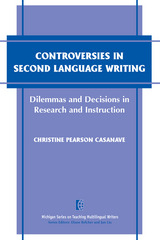
Controversies in Second Language Writing
Dilemmas and Decisions in Research and Instruction
Christine Pearson Casanave
University of Michigan Press, 2003
Controversies in Second Language Writing is not a how-to book, but one that focuses on how teachers in L2 writing can be helped to make reasoned decisions by understanding some of the key issues and conflicting opinions about L2 writing research and pedagogy. This book will assist teachers in making informed decisions about teaching writing in the ESL classroom.
To counteract some of the debates, Casanave explores the different sides of the arguments and provides examples of how other teachers have dealt with these issues. The book presents novice and seasoned teachers with thought-provoking issues and questions to consider when determining and reflecting on their own teaching strategies and criteria.
Topics discussed include:
contrastive rhetoric
product vs. process
fluency and accuracy
assessment of student work
audience
plagiarism
politics and ideology.
To counteract some of the debates, Casanave explores the different sides of the arguments and provides examples of how other teachers have dealt with these issues. The book presents novice and seasoned teachers with thought-provoking issues and questions to consider when determining and reflecting on their own teaching strategies and criteria.
Topics discussed include:
contrastive rhetoric
product vs. process
fluency and accuracy
assessment of student work
audience
plagiarism
politics and ideology.
[more]
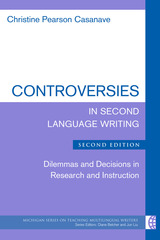
Controversies in Second Language Writing, Second Edition
Dilemmas and Decisions in Research and Instruction
Christine Pearson Casanave
University of Michigan Press, 2017
In the years since the first edition of Controversies in Second Language Writing was published, there been little to no clear resolution of the controversies Casanave so accessibly and fair-mindedly laid out. In fact, many of them have become far more complex and intertwined with many other 21st century issues that teachers of L2 writing cannot help but be affected by in their classrooms. Therefore, this second edition has set out to address: What issues if any have been resolved? What issues have had lasting power from the past, either because people are resistant to change or because the issues continue to be unresolved ones that writing teachers and scholars need to keep discussing?
The second edition is a thorough revision with all chapters updated to refer to works written since the first edition was published. A few chapters have been added: one devoted to writing in a digital era (Chapter 3); one devoted to the debates about English as a lingua franca, "translingual literacy practices," and other hybrid uses of English that have been ongoing in the last ten years (Chapter 4); and one giving special attention to issues related to writing from sources and plagiarism (Chapter 6).
As with the first edition, the second edition of Controversies is not a book that will teach readers how to do things. Rather, it is a book designed to help readers think and to wrestle with issues in L2 writing that are not easily resolved by how-to prescriptions.
The second edition is a thorough revision with all chapters updated to refer to works written since the first edition was published. A few chapters have been added: one devoted to writing in a digital era (Chapter 3); one devoted to the debates about English as a lingua franca, "translingual literacy practices," and other hybrid uses of English that have been ongoing in the last ten years (Chapter 4); and one giving special attention to issues related to writing from sources and plagiarism (Chapter 6).
As with the first edition, the second edition of Controversies is not a book that will teach readers how to do things. Rather, it is a book designed to help readers think and to wrestle with issues in L2 writing that are not easily resolved by how-to prescriptions.
[more]
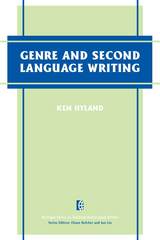
Genre and Second Language Writing
Ken Hyland
University of Michigan Press, 2004
Second language students not only need strategies for drafting and revising to write effectively, but also a clear understanding of genre so that they can appropriately structure their writing for various contexts. Over that last decade, increasing attention has been paid to the notion of genre and its central place in language teaching and learning. Genre and Second Language Writing enters into this important debate, providing an accessible introduction to current theory and research in the area of written genres-and applying these understandings to the practical concerns of today's EFL/ESL classroom. Each chapter includes discussion and review questions and small-scale practical research activities. Like the other texts in the popular Michigan Series on Teaching Multilingual Writers, this book will interest ESL teachers in training, teacher educators, current ESL instructors, and researchers and scholars in the area of ESL writing.
[more]
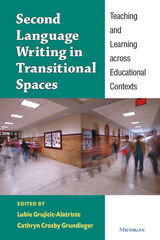
Second Language Writing in Transitional Spaces
Teaching and Learning across Educational Contexts
Lubie Grujicic-Alatriste and Cathryn Crosby Grundleger
University of Michigan Press, 2020
This collection has been written to address the fact that there seems to be little concerted, systematic effort to understand what type of writing is taught across elementary, secondary, and college second language (L2) writing contexts and to understand how it is being taught on this long educational continuum (K–16). This book sets out to contribute to what is perceived as a lack of the full picture on the teaching of L2 writing from K–16. The impetus to look across educational settings, particularly at the places of transitions, stemmed in part from the recent state-wide educational reforms. Given the gap in the L2 research that straddles all educational settings, this volume addresses the need for a closer teacher collaboration and deeper, clearer understanding of writing goals in each of the educational settings and across them on the K–16 continuum.
The chapters examine the writing that English learners are producing because of the Common Core and the writing they are required to do once they reach the college or university, and then consider where the intersections exist—that is, what do educators think English learners ought to be writing across educational levels?
Each chapter describes the educational setting where the researchers were engaged, examines specific issues related to transitions, and offers—where relevant—recommendations for classroom practices, teaching strategies, and instructional materials that may be useful for practicing teachers and all others professionally engaged in educating writers across K–16.
The chapters examine the writing that English learners are producing because of the Common Core and the writing they are required to do once they reach the college or university, and then consider where the intersections exist—that is, what do educators think English learners ought to be writing across educational levels?
Each chapter describes the educational setting where the researchers were engaged, examines specific issues related to transitions, and offers—where relevant—recommendations for classroom practices, teaching strategies, and instructional materials that may be useful for practicing teachers and all others professionally engaged in educating writers across K–16.
[more]
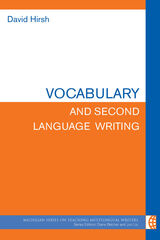
Vocabulary and Second Language Writing
David Hirsh
University of Michigan Press, 2021
In this volume, David Hirsh compellingly makes the case for why vocabulary should be a necessary component of L2 writing proficiency and L2 writing instruction. He examines why vocabulary size and context matter, how productive use of vocabulary can be scaffolded, how to treat vocabulary errors, and the ways that technology like corpora and concordances can support teachers and improve students’ independent vocabulary acquisition. In fact, one chapter is devoted to fostering learner autonomy, an important contribution to pedagogy that is often neglected in similar texts.
Each chapter concludes with a list of key points and tasks and discussion questions for pre- and in-service instructors. Several chapters also include sample activities for teaching vocabulary at various instructional levels, designed to encourage readers to consider more deeply how they will include vocabulary instruction in their classrooms.
Vocabulary and Second Language Writing will be an excellent guide for all college-level writing instructors and help them understand the critical role that vocabulary plays in writing quality—something that is often disregarded in favor of holistic features like genre and rhetoric. The volume may also be useful for writing center administrators and those who train writing tutors.
Each chapter concludes with a list of key points and tasks and discussion questions for pre- and in-service instructors. Several chapters also include sample activities for teaching vocabulary at various instructional levels, designed to encourage readers to consider more deeply how they will include vocabulary instruction in their classrooms.
Vocabulary and Second Language Writing will be an excellent guide for all college-level writing instructors and help them understand the critical role that vocabulary plays in writing quality—something that is often disregarded in favor of holistic features like genre and rhetoric. The volume may also be useful for writing center administrators and those who train writing tutors.
[more]
READERS
Browse our collection.
PUBLISHERS
See BiblioVault's publisher services.
STUDENT SERVICES
Files for college accessibility offices.
UChicago Accessibility Resources
home | accessibility | search | about | contact us
BiblioVault ® 2001 - 2024
The University of Chicago Press









